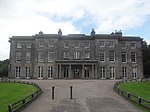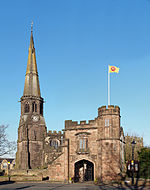
St Mary's Church is in Knowsley Lane, Knowsley Village, Merseyside, England. The church is recorded in the National Heritage List for England as a designated Grade II* listed building. It is an active Anglican parish church in the diocese of Liverpool, the archdeaconry of Liverpool and the deanery of Huyton. In the Buildings of England series, Pollard and Pevsner describe the church as being "largish" with "an intimate interior".

The Parish Church of St Mary the Virgin is a Church of England parish church in Leigh, Greater Manchester, England. It is a member of the Salford & Leigh deanery in the archdeaconry of Salford, diocese of Manchester. It is recorded in the National Heritage List for England as a designated Grade II* listed building.
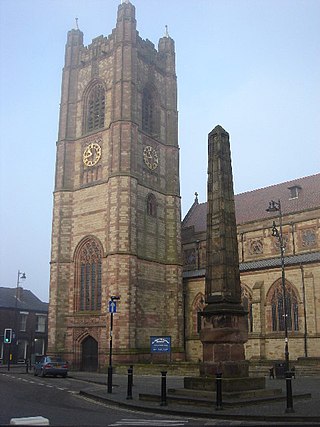
St John the Baptist's Church is in Market Place, Atherton, Greater Manchester, England. It is an active Anglican parish church in the archdeaconry of Salford, and diocese of Manchester. Together with St George's and St Philip's Churches in Atherton and St Michael and All Angels at Howe Bridge, the church is part of the United Benefice of Atherton and Hindsford with Howe Bridge. It is recorded in the National Heritage List for England as a designated Grade II listed building.

Christ Church is in the village of Glasson, Lancashire, England. It is an active Anglican parish church in the deanery of Lancaster and Morecambe, the archdeaconry of Lancaster, and the diocese of Blackburn. Its benefice is combined with those of St Michael, Cockerham, and St Luke, Winmarleigh. The church is recorded in the National Heritage List for England as a designated Grade II listed building.

Holy Trinity Church, Morecambe, or Morecambe Parish Church, is in Church Street, Morecambe, Lancashire, England. It is the Anglican parish church of Morecambe, in the deanery of Lancaster, the archdeaconry of Lancaster and the diocese of Blackburn. The church is recorded in the National Heritage List for England as a designated Grade II listed building.
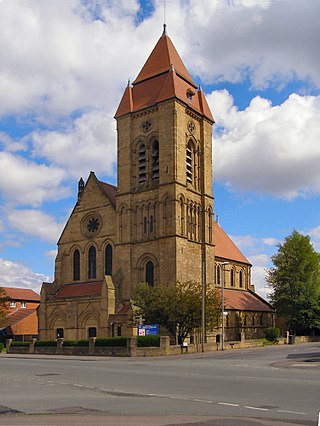
The Church of St John the Evangelist is in Waterloo Road, Cheetham Hill, Manchester, England. It is an active Anglican parish church in the deanery of North Manchester, the archdeaconry of Manchester, and the diocese of Manchester. The church is recorded in the National Heritage List for England as a designated Grade II* listed building.

St Oswald's Church is an Anglican church in Preesall, a town on the Fylde coastal plain in Lancashire, England. It is an active parish church in the diocese of Blackburn and the archdeaconry of Lancaster. It was built 1896–1898, designed by Hubert Austin, and is recorded in the National Heritage List for England as a designated Grade II listed building.

St Leonard's Church is an Anglican church in Walton-le-Dale, Lancashire, England. It is an active parish church in the Diocese of Blackburn and the archdeaconry of Blackburn. In 1950 it was designated as a Grade II* listed building. Parts of the church date from the 16th century and the nave and transepts were rebuilt in the early 20th century.

Christ Church is in Ince Green Lane, Lower Ince, Ince-in-Makerfield, Greater Manchester, England. It is an active Anglican parish church in the deanery of Wigan, the archdeaconry of Warrington, and the diocese of Liverpool. Its benefice is combined with that of St Catharine, Wigan. The church is recorded in the National Heritage List for England as a designated Grade II listed building.

St Thomas' Church is in Eskrick Street, Halliwell, a residential area of Bolton, Greater Manchester, England. It is an active Anglican parish church in the deanery of Bolton, the archdeaconry of Bolton, and the diocese of Manchester. Its benefice is united with those of five other local churches to form the Benefice of West Bolton. The church is recorded in the National Heritage List for England as a designated Grade II* listed building.

St Peter's Church is in Firs Lane, Westleigh, a district of Leigh, Greater Manchester, England. It is an active Anglican parish church in the deanery of Leigh, the archdeaconry of Salford, and the diocese of Manchester. The church is recorded in the National Heritage List for England as a designated Grade II* listed building. It was designed by the Lancaster architects Paley and Austin. The architectural historians Pollard and Pevsner describe it as "one of their most radical and thrilling churches".

St Mary's Church is in the town of Windermere, Cumbria, England. It is an active Anglican parish church in the deanery of Windermere, the archdeaconry of Westmorland and Furness, and the diocese of Carlisle. Its benefice is united with that of St Martin's Church, Bowness-on-Windermere; St Anne's Church, Ings; St Cuthbert's Church, Kentmere; St James' Church, Staveley and Jesus Church, Troutbeck. The church is recorded in the National Heritage List for England as a designated Grade II listed building.

St Michael and All Angels with St Marks Church is in Egerton Road, Ashton-on-Ribble, Preston, Lancashire, England. It is an active Anglican parish church in the deanery of Preston, the archdeaconry of Lancaster, and the diocese of Blackburn. Its benefice is united with those of St Mark, Preston, and St Andrew, Ashton-on-Ribble, to form the benefice of the West Preston Team. The church is recorded in the National Heritage List for England as a designated Grade II* listed building.

St Michael's Church is in the village of Bootle, Cumbria, England. It is an active Anglican parish church in the deanery of Calder, the archdeaconry of West Cumberland, and the diocese of Carlisle. Its benefice has been united with those of St John the Baptist, Corney, St Mary, Whicham, and St Mary, Whitbeck. The church is recorded in the National Heritage List for England as a designated Grade II listed building.
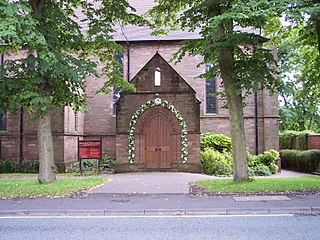
St Matthew's Church is in Billinge Road, Highfield, Pemberton, Wigan, Greater Manchester, England. It is an active Anglican parish church in the deanery of Wigan, the archdeaconry of Wigan & West Lancashire, and the diocese of Liverpool. The church is recorded in the National Heritage List for England as a designated Grade II* listed building.
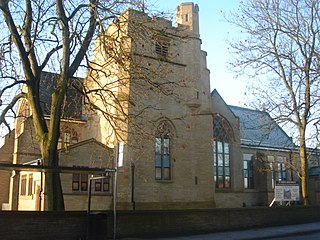
St Anne's Church is a redundant Anglican parish church in Tyldesley Road, Hindsford, Atherton, Greater Manchester, England. It is recorded in the National Heritage List for England as a designated Grade II listed building.

St Mary's Church is on the A595 road in Whicham, Cumbria, England. It is an active Anglican parish church in the deanery of Calder, the archdeaconry of West Cumberland, and the diocese of Carlisle. Its benefice is united with those of St Michael, Bootle, St John the Baptist, Corney, and St Mary, Whitbeck. The church is recorded in the National Heritage List for England as a designated Grade II listed building.

All Saints Church is in Delph Lane, Barnacre-with-Bonds, Lancashire, England. It is an active Anglican parish church in the deanery of Garstang, the archdeaconry of Lancaster, and the diocese of Blackburn. Its benefice is united with those of St Peter, Scorton, and St John the Evangelist, Calder Vale. The church is recorded in the National Heritage List for England as a designated Grade II listed building.

St Michael & All Angels Church is located to the southwest of the English village of Cockerham, Lancashire. It is an active Anglican parish church in the deanery of Lancaster, the archdeaconry of Lancaster and Morecambe, and the diocese of Blackburn. Its benefice is combined with those of Christ Church, Glasson, and St Luke, Winmarleigh. The church is recorded in the National Heritage List for England as a designated Grade II* listed building.

St Stephen's Church is in Balcarres Avenue, Whelley, Wigan, Greater Manchester, England. It is an active Anglican parish church in the deanery of Wigan, the archdeaconry of Wigan and West Lancashire, and the diocese of Liverpool. Its benefice is united with that of St John, New Springs. The church is recorded in the National Heritage List for England as a designated Grade II listed building.























